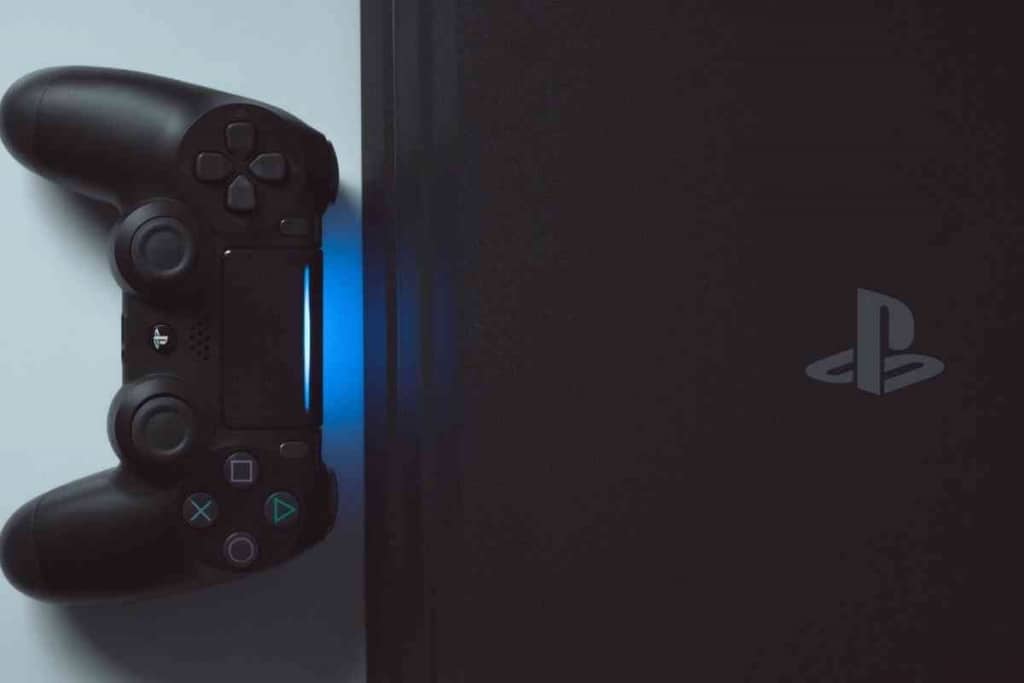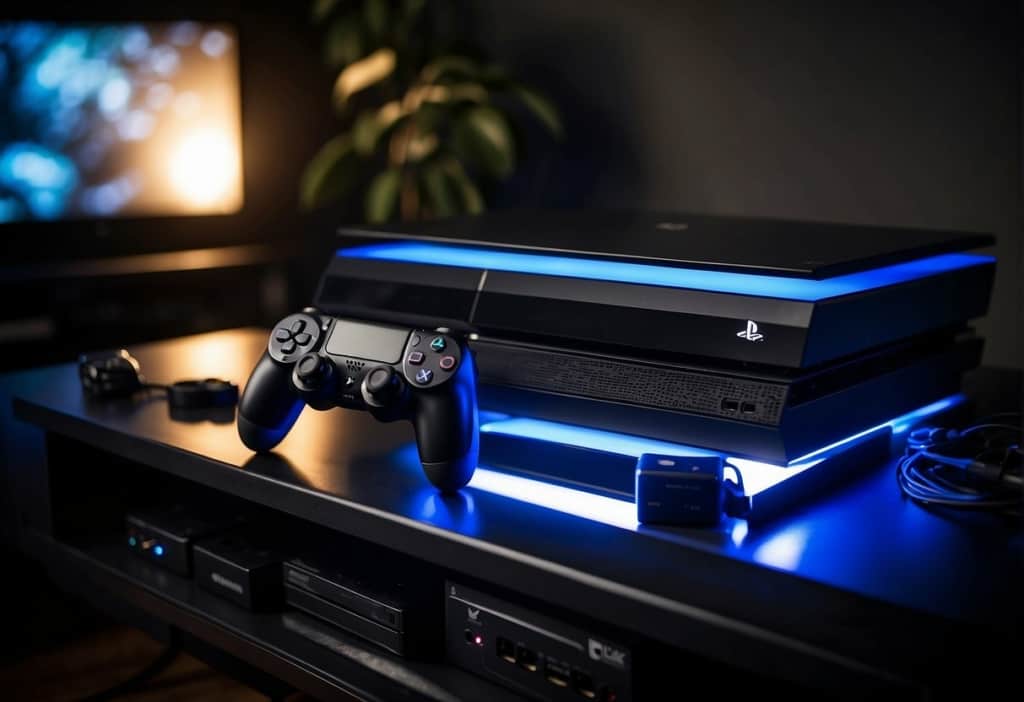PS4 Blinking Blue Light: Quick Fix Guide (2024)
Struggling with the dreaded PS4 Blinking Blue Light issue? Discover quick and effective solutions to get your gaming back on track in our comprehensive guide.

The PS4 Blinking Blue Light, often termed the ‘Blue Light of Death,’ indicates a serious malfunction. It usually happens due to issues like HDMI faults, power supply problems, or hardware failures. To fix it, check the HDMI cable, reset the console, and ensure proper ventilation. If these steps don’t work, it might require professional repair or contacting Sony’s customer support for further assistance.
Understanding the PS4 Blinking Blue Light
When you encounter a blinking blue light on your PS4, it signals a state commonly known as the Blue Light of Death (BLOD). This is an indicator of a potential hardware or software issue that prevents the console from operating normally. Here’s what the blue light on your PS4 might signify:
- Flashing Blue Light: The PS4 blue light blinking on and off usually points to video output problems or a defective connection between the console and the TV.
- Solid Blue Light: A blue light that remains solid could suggest a more serious hardware malfunction.
Common Associations of the Blue Light
| Blue Light Status | Possible Meaning |
|---|---|
| Blinks and Turns Off | System starting up — no issues if it transitions to white |
| Continuous Blinking | System error or hardware failure |
| Solid Blue | Potential power supply problems |
If the blue light on your PlayStation 4 is blinking, it is crucial to address it promptly:
- Check Cable Connections: Verify that all cables are secure and the HDMI port isn’t damaged.
- Safe Mode: Attempt to start your PS4 in Safe Mode by holding the power button until you hear two beeps.
- Power Cycle: Turn off the console, unplug it, wait a few minutes, and plug it back in.
- Update or Reinstall System Software: If possible, update the console’s software or reinstall it through Safe Mode.
Remember that if these steps do not resolve the issue, professional repair may be necessary. Ignoring the blue light could lead to further damage to your system.
Common Causes for the PS4 Blue Light of Death
The PS4 Blue Light of Death (BLOD) is a common issue where your console’s light bar flashes blue and the PS4 doesn’t fully boot up. Identifying the underlying problems can help you apply the right solutions.
Hardware Issues:
- Power Supply: A faulty power supply can prevent your PS4 from turning on properly.
- HDMI Cable: A damaged HDMI cable may not transmit data correctly from your PS4 to the TV.
- Hard Drive: Problems with the PS4 internal hard drive can manifest as BLOD.
Software Glitches:
- Firmware Bugs: The PS4 operating system may have bugs that cause a blinking blue light of death.
- Incompatible Software: Software that conflicts with the PS4’s firmware could lead to the blue light persistently blinking.
Solutions to Consider:
- Power Cycle: Completely turn off your PS4 and unplug for a few minutes before restarting.
- HDMI Check: Examine and replace your HDMI cable if necessary.
- Hard Drive Inspection: Ensure the hard drive is properly seated and, if needed, consider replacing it.
- Database Rebuild: You can rebuild your PS4’s database to fix software errors.
- Firmware Update: Keep your system updated with the latest firmware to prevent software issues.
Blinking Patterns and Diagnosis: If the blue light simply pulses or the PS4 Pro’s blue light is blinking steadily, it’s usually a sign of a hardware failure. Intermittent blue light often points to software glitches.
Your PS4’s health is pivotal for uninterrupted gameplay. Recognizing these causes helps you to perform a blue light of death PS4 fix effectively.
Troubleshooting Steps
When your PS4 exhibits a blinking blue light, it could indicate hardware or software issues. Addressing this effectively requires a methodical approach to identify and resolve the underlying problem.
Performing a Power Cycle
To reset your PS4 and clear temporary glitches:
- Turn it off completely by pressing and holding the power button until it beeps twice.
- Unplug the power cord from both the console and the electrical outlet.
- Wait for at least 3-5 minutes before reconnecting everything and powering on the device.
Checking HDMI and Power Connections
Faulty cables can often cause the blue light of death:
- Inspect your HDMI and power cables for any signs of damage such as rips or tears.
- Ensure that all connections are secure and free from dust and debris.
- If you find damage, replace the faulty cable and test if the issue persists.
Booting in Safe Mode
If standard boot doesn’t work, try to start your PS4 in Safe Mode:
- Press and hold the power button until you hear the second beep, approximately seven seconds later.
- Connect the DualShock 4 controller using the USB cable and press the PS button.
Rebuilding PS4 Database
Corrupted data might cause the blue light error. To defrag the PS4 and clean up the data:
- Boot into Safe Mode as per the previous instructions.
- Select the “Rebuild Database” option (this may take some time and cannot be undone).
This process can resolve issues like the PS4 black screen with a blue light, and improve system performance without deleting any of your data.
Hardware Solutions
When your PS4 controller flashes a blue light and does not turn on, it may indicate hardware issues. Addressing these effectively often involves inspecting and potentially replacing certain components of your console.
Hard Drive Inspection and Replacement
Your PS4’s hard drive is essential for booting up your console. If you find the blue light flashing and your PS4 not turning on, the hard drive could be at fault.
- Check the hard drive connection: Ensure the hard drive is properly seated and securely connected.
- Inspect for physical damage: Look for any signs of damage on the hard drive. If you notice any, the hard drive needs to be replaced.
- Test with a new hard drive: If possible, replace the current hard drive with a new one to see if the issue persists.
Power Supply Unit Check
A faulty Power Supply Unit (PSU) can also manifest as a blue light that flashes but does not turn the console on.
- Listen for unusual sounds: A healthy PSU should not make any loud noises. Buzzing or clicking sounds can signal a PSU problem.
- Inspect the power cables: Ensure all power cables are firmly connected and undamaged.
- Check for power from the outlet: Verify that the electrical outlet is providing power using other devices.
By methodically checking these hardware components, you can isolate the problem and find a suitable PS4 blue light fix.
Identifying Defective Components
When your PlayStation 4 has a blinking blue light, it could be a sign of hardware issues. The infamous “Blue Light of Death” indicates that your PS4, especially models like the PS4 Slim, is experiencing a malfunction that prevents it from turning on properly. Here’s what you need to check to identify the defective components:
- Power Supply: A failing power supply can lead to a blinking blue light. Check for any damage or wear on the power cord and ensure that the connection is secure.
- HDMI Cable: Look for any visible damage to the HDMI cable that connects your PS4 to your television. Sometimes a faulty HDMI can present as a blinking blue light.
- Hard Drive: The PS4’s internal hard drive might be the issue. Listen for unusual sounds from the hard drive area or consider if there have been errors in data storage or retrieval.
Consider the following checklist to inspect common hardware issues:
- Checklist for PS4 Slim Blue Light Blinking:
- Inspect the power supply for wear and ensure all cables are firmly connected.
- Test with a different HDMI cable to rule out a connection problem.
- If comfortable, remove the hard drive bay cover and check the hard drive is firmly seated.
If the PlayStation 4 is not turning on and has a blinking blue light, after inspecting these components, seek professional repair services to further diagnose and fix the internal hardware issues that may be causing the blinking blue light. It’s vital to tackle these problems promptly to prevent further damage to your console.
When to Seek Professional Repairs

If you’re facing issues with your PS4, such as the blue light not turning on or a blinking blue light without the system powering up, it’s important to assess when professional repair is needed. Follow these guidelines to determine if expert help is required:
- Persistent Blue Light: If the light remains blue and the console does not shift to white, indicating it’s not properly booting up, expert intervention may be needed.
- No Video/Audio: When there is a blue light but no signal to the TV, a professional can check for HDMI port issues.
- Unsuccessful Safe Mode Boot: Attempt to start your PS4 in Safe Mode. If it fails, there might be a deeper hardware or software issue.
Diagnosis Steps:
- Check Power Supply: Make sure your PS4’s power supply is functional; if the problem persists, it could be internal.
- Examine HDMI Cable: Look for damage. If everything seems fine, but no signal appears, the port could be the problem.
- Safe Mode: Try to boot in Safe Mode. If unsuccessful, the PS4 system might need a professional diagnosis.
- Initial Troubleshooting Fails: If the common home remedies like power cycling or data rebuilding don’t work, it’s time to consult a technician.
Remember, while some issues can be resolved with simple steps like checking cables or restarting the device, certain problems with your PS4, such as when it won’t turn on or is accompanied by a blinking blue light, might signal a need for professional repair services. It’s better to be safe and let experts handle sophisticated repairs than to risk further damage by attempting to fix complex hardware issues on your own.
Preventive Measures and Maintenance
Keeping your PS4 in good condition is essential to preventing issues like the pulsing blue light, which is often associated with what is termed the “Blue Light of Death.” Here are some steps to help maintain your console and keep it running smoothly:
- Ventilation: Ensure your PS4 has good ventilation. Keep it in an open space where air can circulate freely around it to prevent overheating.
- Dust-free Environment: Regularly clean the area around your PS4. Accumulated dust can block vents and lead to overheating, which may cause hardware malfunctions indicated by a blue pulsing light.
Regular Maintenance Tips:
- Turn off properly: Always turn off your PS4 properly through the menu options. Abruptly unplugging the console can lead to power supply issues.
- Keep system updated: Install system updates as they’re released. These can improve system stability and prevent various issues, including the PS4 pulsing blue light.
- Check cables: Inspect all cables periodically for damage. A faulty HDMI cable can cause display issues or even trigger the blue light warning.
Troubleshooting Beforehand:
- If your PS4 starts to show signs of the blue light error, try to disconnect the power cord and leave it unplugged for a few minutes before reconnecting. This can sometimes reset the system and resolve minor power issues.
By following these guidelines, you can help ensure the longevity of your PS4 and reduce the chances of encountering the dreaded blue light of death. Remember, consistent care and early troubleshooting can save you from more significant issues down the line.